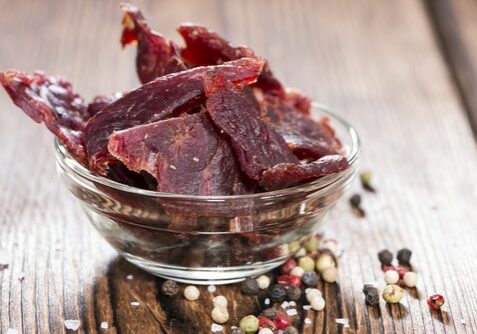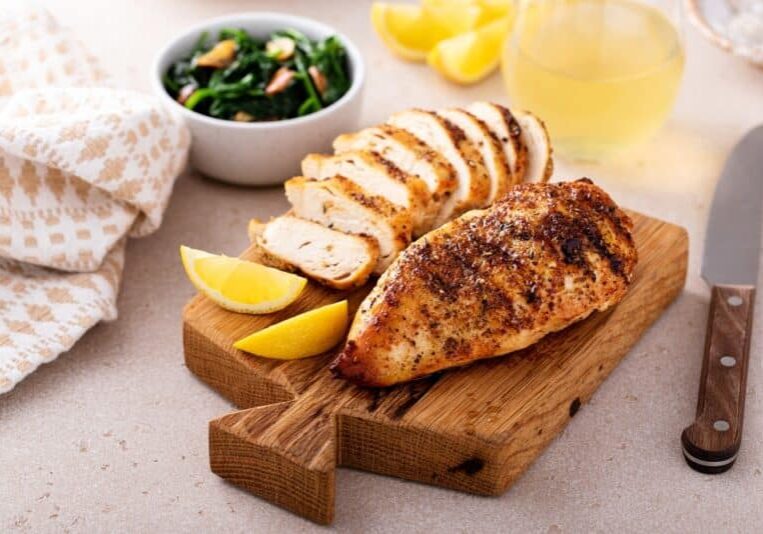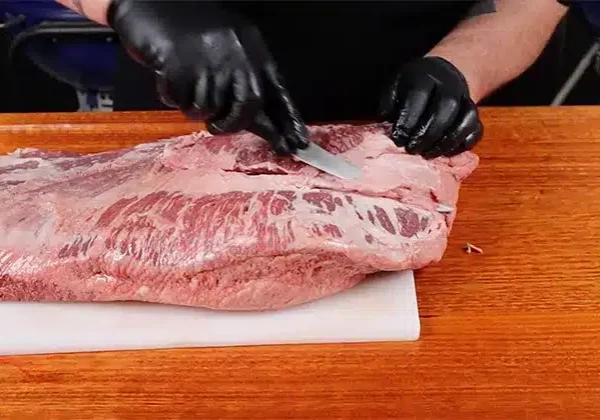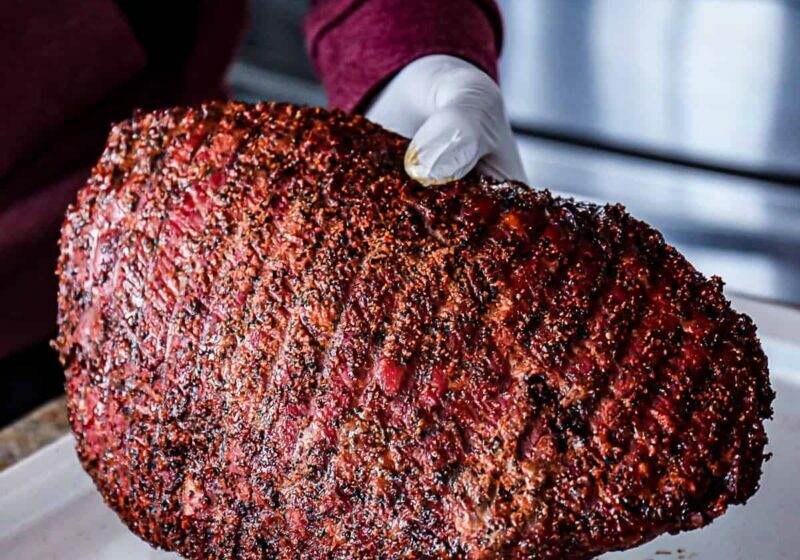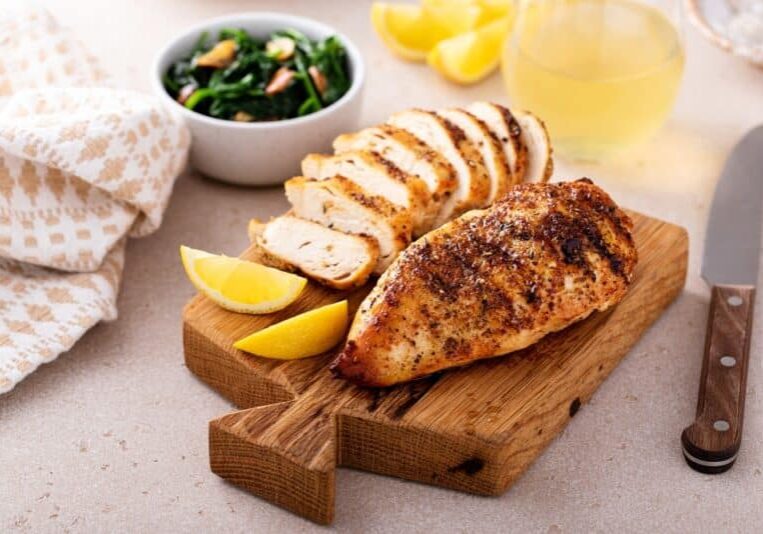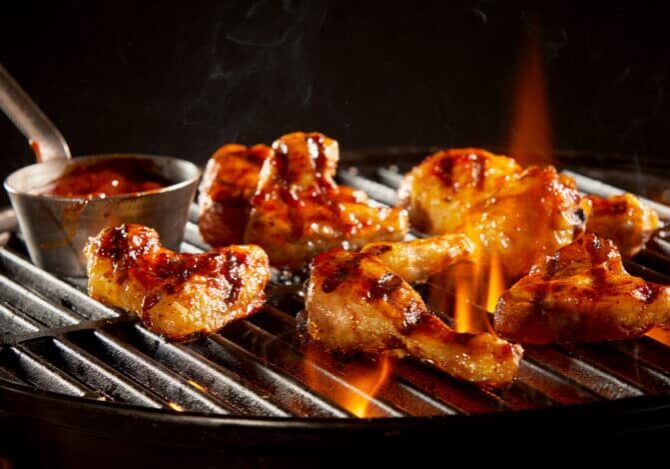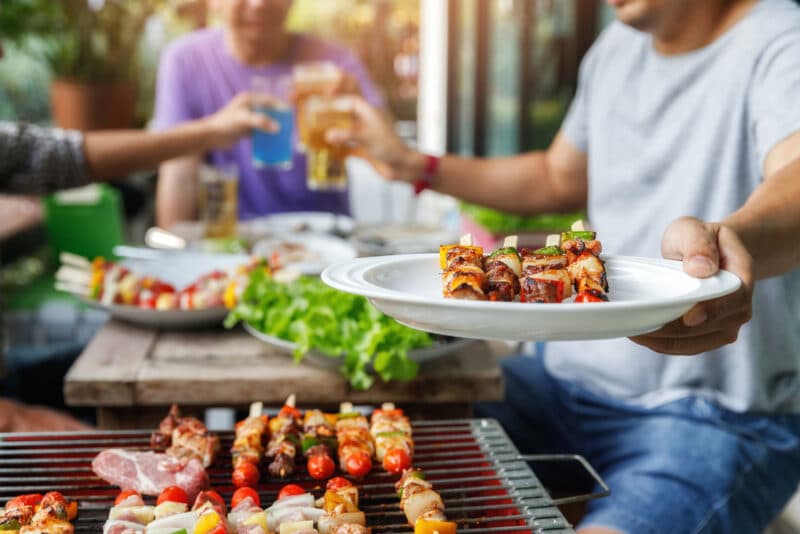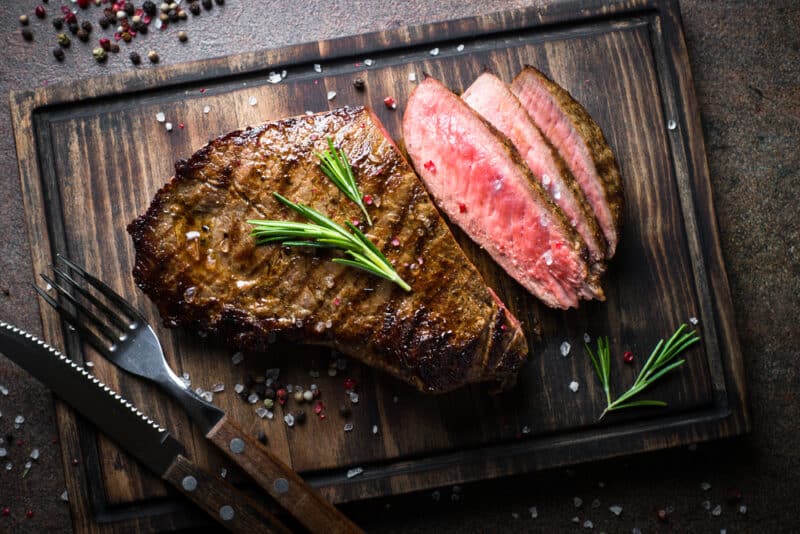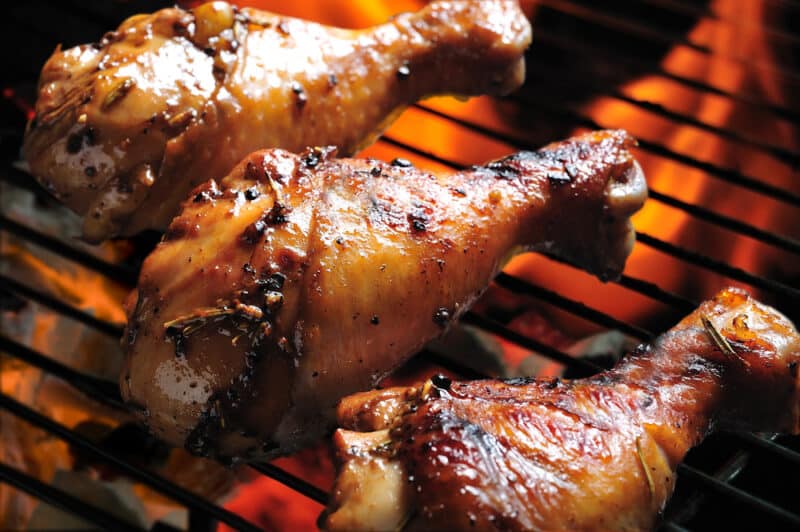How to Grill Frozen Burgers
TheGrillingMaster.com is reader-supported. If you buy something using the links on our site, we might earn an affiliate commission at no added cost to you. This helps us pay our staff to keep making awesome content for you!
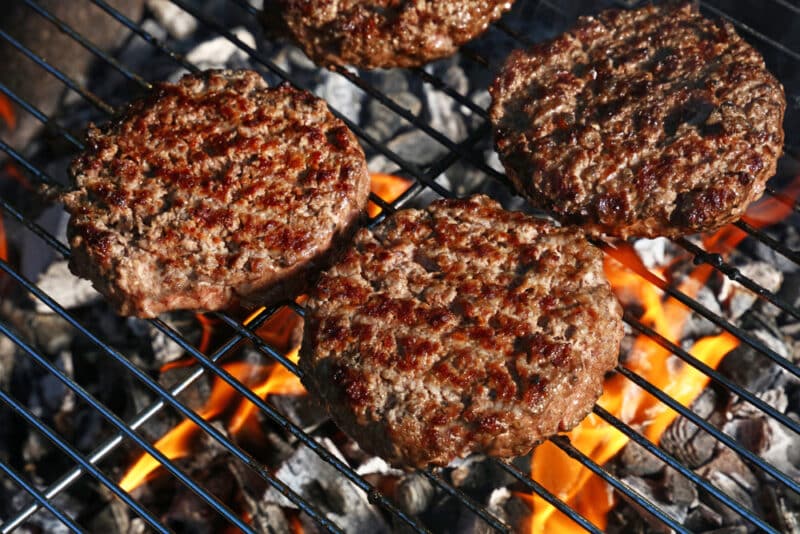
Can you grill frozen burgers? Yes, you can! It’s almost summer, and we’re all excited and looking forward to all the fun outdoor activities that are in store. We can smell the aroma and taste the smoky flavor and juicy texture of grilled burgers as we anticipate summertime backyard barbecues and camping meals.
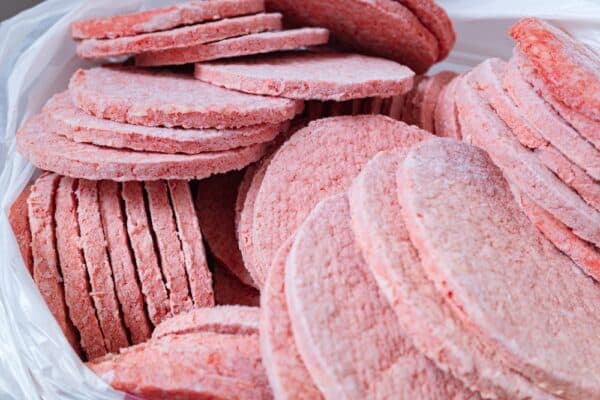
However, if you are as impulsive as me, you’re sure to frequently find yourself without time to thaw ground beef for making fresh beef patties.
No need to worry! This article will show you how to quickly and easily make delicious frozen beef burgers as good as fresh ones. You don’t need to thaw the burgers out beforehand. Grilling burgers directly from frozen will give you a juicy and flavorful patty in no time.
Read on for some helpful step-by-step tips and advice on how to grill frozen burgers, starting with what might be the most challenging step.
Separating Frozen Burgers
The difficulty of separating frozen burgers can be incredibly annoying. We can all relate to this issue, but there is an effortless solution.
Normally, the patties are kept separate with thin parchment paper; however, it tends to rip when you try to take them apart.
The simplest way to split the burgers is to carefully use a butter knife and ease it between the patties to separate them.
Be cautious, though, the blade could slip and will cause pain if it stabs your fingers or hands.
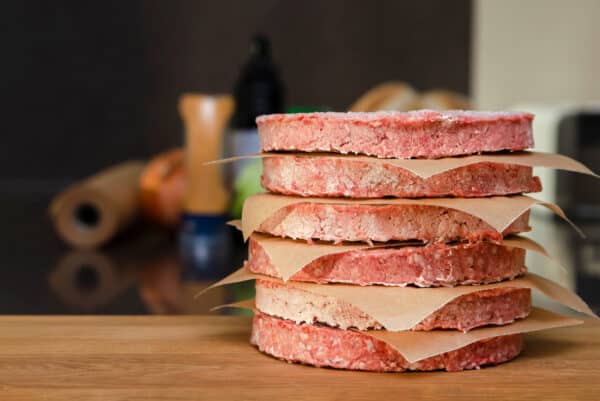
Related Reading>> How to shape burgers
Seasoning Frozen Burgers
It can be hard to season frozen meat perfectly. So, what’s the best way to season frozen burger patties? People have different ideas about it, depending on their taste and the burgers themselves.
Here are some popular ways to season them.
- Rub the frozen patties with oil, to hold the seasoning
- Sprinkle with salt and pepper while frozen
- Wait until burgers start to thaw before seasoning
- Spray with Worcestershire sauce diluted with water for flavor and moistness
The results of the different burger seasoning methods are pretty similar. Though, the oil rub might make your burgers taste a bit oily.
Really, it’s up to your taste—you can go with something classic like salt and pepper. Add onion powder, or garlic powder, or try out some more creative seasonings.
Just be careful not to use too much, since you want to avoid overpowering the hamburger meat’s flavor.
If you’re unsure where to start, a bit of cheese, onions, crispy lettuce, ketchup or BBQ sauce, and a homemade garlic sauce are always good options.
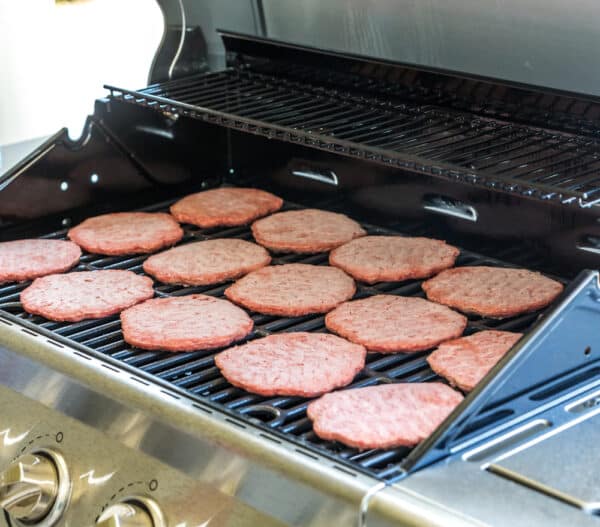
How To Grill Frozen Burgers
Once you’ve separated the frozen burgers and seasoned them if you like, it’s time to get grilling.
Turn the heat on the grill lower than you would for regular patties. That way, you’ll get a good sear without the burgers still being frozen in the middle.
At What Temperature Should the Grill Be?
You need to be extra careful when grilling frozen burgers. It’s easy to burn the outside before the inside is done, so you need to be sure to preheat the grill to a temperature between 325° and 375°F and set it up for two-zone or indirect cooking.
That’ll help make sure you don’t end up with a charred patty, frozen inside.
If your grill or smoker has a thermometer, heating it up is a piece of cake. But grilling on charcoal or gas without a thermometer is a bit harder.
Experienced grillers can guess the temps by doing the ‘hand test’—it’s not exact, but it works.
Related reading >> Best Meat for Jerky
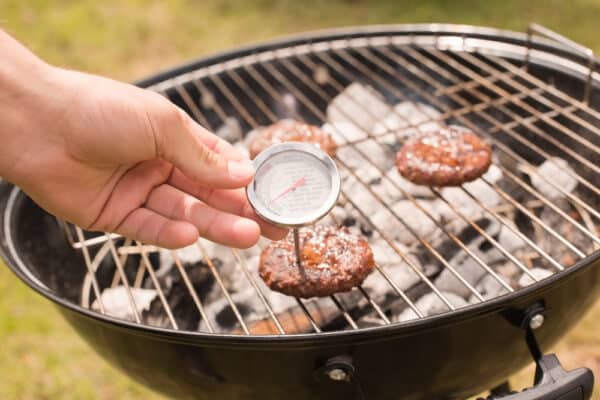
Here’s how they do it:
- To check the temperature of your grill, hold your hand above it at the same height as a soda can.
- If it takes 7 to 9 seconds for you to feel the heat, the temperature should be between 250 and 300 degrees.
- If it takes 6 to 7 seconds, it’s likely a medium-high heat between 300 and 350 degrees.
- Any shorter than that, it’s probably over 350.
- Be careful though, you want to avoid burning your hand!
Related reading: How to reheat steak
Clean the Grill
If you didn’t give your grill grates a good scrub after the last time you used it, they’re likely to still have bits of food, leftover char, or gunk on them.
Grilling your burgers before cleaning the grates could cause them to stick, it could affect the taste, and bits of leftover fat could cause flame flare-ups.
So, once the grill is hot, give the cooking grates a good clean before popping the burger patties on. You can use a special grill scraper or steel brush to do this.
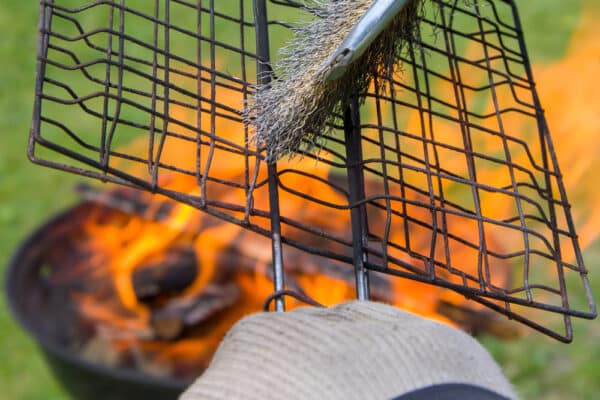
How Does Two-Zone Grilling Work?
Grilling can often lead to uneven cooking with the exterior becoming overcooked while the interior remains raw. This is due to the direct heat that exposes the food to high temperatures and is responsible for causing the outside to cook rapidly. To counteract this problem, allow me to introduce the two-zone grilling technique! This way of grilling creates separate areas for direct and indirect heat and allows you to control the cooking process more effectively.
To get perfect burgers with the ideal char and have control over the doneness of the inside of the frozen burger, you have two options.
- Grill the frozen burgers for a longer period on a lower heat than the recommended temperature between 325° and 375°F.
- Set up your grill in two zones — a cooler side with indirect heat, and a hot side measuring between 325° and 375°F.
Two-Zone grilling means you start the process with the frozen burgers on the cooler side of the grill to gradually thaw and start cooking inside.
Once they are defrosted, you move them over to the hot grill with direct heat to get that perfect sear that we all love.
Benefits of Two-Zone Grilling for Burgers
-
Precise temperature control: Two-zone grilling allows you to manage the cooking temperature more effectively. This way you can make sure your burgers are cooked to perfection. You can sear them on the high heat and then move them to the cooler zone to cook through gently.
-
Versatility: The technique is suitable for different types of grills you might have including charcoal and gas models. This means that you can enjoy the benefits of two-zone grilling no matter what kind of grill you own or are working with that day.
-
Reduced flare-ups: Flare-ups occur when fat drips onto the heat source causing flames to engulf the food. By cooking your burgers in the indirect heat zone, you can reduce the likelihood of flare-ups which means they outside will not get overcooked or burnt. Reduced flare-ups helps in preserving the flavor and appearance of your burgers.
-
Consistent results: Two-zone grilling allows you to achieve consistent results every time you grill! This is something many people struggle with on the grill. This is especially important when cooking for guests or at a barbecue party.
TIPS From the Grilling Master:
- Put the burger patties on the grill with some room between them—don’t pack them too close together because it’ll reduce the temperature and take longer. Moreover, without space between them, the burgers will be steamed instead of grilled.
- Don’t squash them with the spatula while cooking as this will make all the yummy juices come out—and we all want juicy burgers, right?
- Once you’ve grilled a frozen burger on a grill set up for two-zone grilling, you’ll never use your air fryer to prepare them again.
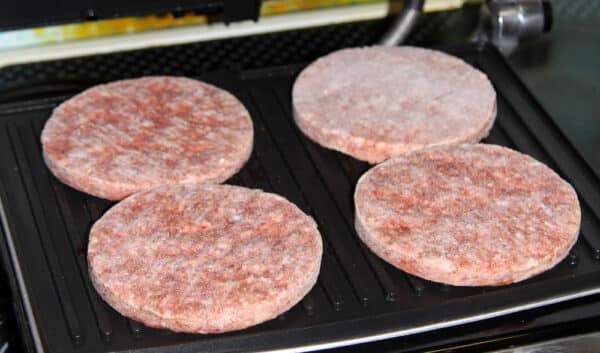
How Long Will It Take to Grill Frozen Burgers?
The most important aspect when deciding how long to grill frozen burgers is making sure they reach an internal temperature of at least 160°F.
The FDA suggests that ground beef should be cooked to a safe internal temperature of 160°F for safety.
This may be difficult if the meat is frozen, as it will take longer to get out of the “danger zone” (between 40° and 140°F).
Even though some people would prefer their burgers to be cooked more medium-rare to medium, food safety must be the priority.
If you have a thermometer built into your griller or smoker, you’re in luck. It makes it a lot easier to get the temperature just right.
If you don’t have one, don’t stress. However, it’s still a good idea to keep some kind of thermometer nearby. You’ll check the inside temperature of the burgers when they’re done.
We recommend cooking the patties for 15 to 20 minutes. The best way to make sure they’re ready is to use the thermometer to determine the temperature in the thickest part of the patty.
Once it reads 160°F, take them off the grill and enjoy!
Related reading >> Best Internal Temp for Brisket
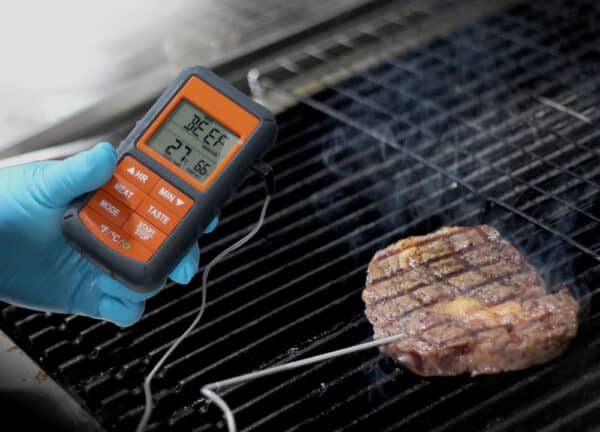
Can You Cook a Frozen Burger to be Medium Rare?
Yes, you can cook your frozen burgers to the doneness you prefer. However, we would recommend you do that only if the burgers were made by you and not bought from a supermarket.
It can be handy to ground your own beef and use your favorite recipe to make a whole batch of burgers to freeze and save prep time later.
Not knowing which microorganisms the ground beef was exposed to during manufacturing makes it safer to grill store-bought patties to a temp of at least 160°F, which will kill any bacteria.
If you’re cooking your own burgers from frozen, here’s a guide to getting the temperature just right. Everyone has different tastes, but generally speaking, the USDA recommends the middle of the meat to be 160 to 165 degrees Fahrenheit.
Related reading >> Can You Eat Raw Steak?
Other options include:
- Rare: 120 to 125°F
- Medium Rare: 130 to135°F
- Medium Well: 150 to155°F
- Well done: 160 to165°F
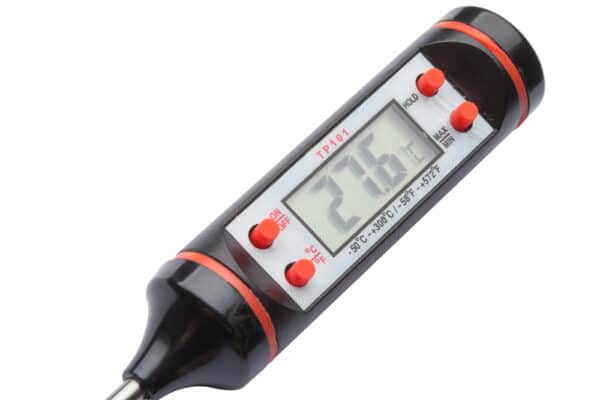
If you are grilling the frozen burgers at a temperature of 350 to 375°F, and your beef burgers are about 1/2-inch thick, the grilling time for frozen burgers would be approximately the cooking times shown below — depending on the thickness of the patty:
- 10 minutes for rare
- 15 minutes for medium rare
- 20 minutes for well done
To get an accurate reading, use a meat thermometer when you take burgers off the grill. These rules also apply when you grill your frozen burgers in a smoker.
Once the burgers reach the desired temperature, take them off the grill and let them sit for a few minutes. Don’t be tempted to poke them with a knife; this will just let all the juicy goodness out, making them dry. Let them rest, and the juices will be evenly spread throughout the burger.
All Done!
While the grill is still hot, you can quickly give the buns a light toast. Spread some melted butter on the flat side of each hamburger bun and place them face-down on the grill.
Be sure to keep the temperature low, so you don’t burn them.
Once everything is done, you’re ready to put the burgers together. Add your favorite toppings and treat your friends and family to a delicious burger main course. You can serve fries on the side, or a healthy, crispy, and fresh salad made at the last minute!
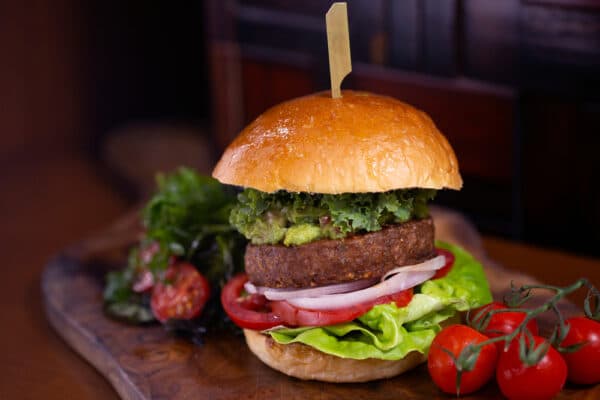
Frequently Asked Questions
Q: How long does it take to grill frozen burgers?
A: To cook frozen burger patties on the grill, first take five minutes to heat it up. Then let the burgers cook until they reach an internal temperature of 160°F on a meat thermometer. This will usually take 15 to 20 minutes on a charcoal grill, gas grill, or smoker, depending on how thick the patties are. So, if you grill the burgers at medium-high heat, the total time will likely be 25 to 30 minutes.
Q: Does the thickness of the patty make a difference in grilling time?
A: The thickness of the burgers will affect how long they need to cook. This guide assumes you’re using ⅓ lb. patties. If you’re using a different size, you should adjust the cooking time to make sure the internal temperature reaches at least 160 degrees. Heavier burgers take more time to cook, while thin hamburgers don’t need as long.
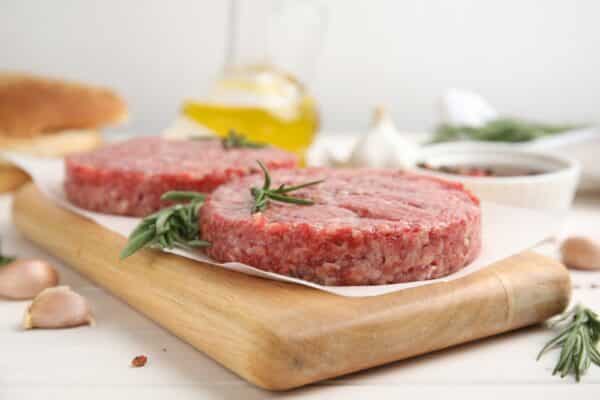
Q: Do you need to season frozen burgers?
A: If you grill burgers that were seasoned before they were frozen, then there is no need to season them, and you’ll be good to go. If not, you can season them with salt, pepper, and any seasonings you choose while they are cooking.
Q: How do you separate frozen burgers?
A: If your frozen burger patties are stuck together, put them on a cutting board on their side and wedge a butter knife in the gap. Tap down on the handle of the knife with your hand, and they should come apart easily.
Q: How long can you keep cooked beef patties in the fridge?
A: If you plan to save burgers for later, put the patties in a container that seals tightly, a plastic bag, or wrap them in foil. According to the FDA, you should eat cooked meat that has been in the fridge within 3 to 4 days. For the best flavor, warm your patty in the microwave, or oven, or fry it in a pan. Make sure to heat it separately from the buns and any fresh toppings.
Q: How long do beef patties keep in the freezer?
A: The FDA recommends consuming beef burgers within 2 to 3 months if kept in the freezer.
Q: Is it safe to grill frozen hamburger patties?
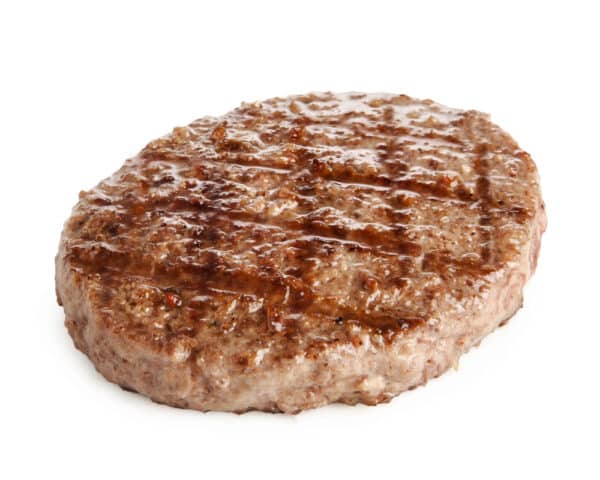
A: Yes, it’s totally safe to cook burgers from frozen. The USDA says it’s okay to grill meat and poultry from frozen, as long as it reaches the right temperature—for ground beef that’s 160°F. However, it’ll take longer to cook from frozen than if you defrost it overnight in the fridge. That said, it doesn’t really matter with thin burgers as they cook evenly either way. So don’t worry if you forget to thaw it out. The same applies to turkey burgers, chicken burgers, and veggie burgers, options that are often chosen by kcal watchers.
Learn More About Grilling
If you want to learn more about grilling, check out these other helpful resources!

Kevin Turner
Hi there, I'm Kevin Turner, Founder and CEO of thegrillingmaster.com. I started this website to share my passion and knowledge with you. You can leverage my years of experience as a pit master and professional to grill great food!
About The Grilling Master
Hi there, I'm Kevin Turner, Founder and CEO of thegrillingmaster.com.
My passion has always been grilling, smoking and BBQ delicious meats that satisfy my inner carnivore!
I started this website to share my passion and knowledge with you, the hungry reader who wants to prepare the perfect meal.
You can leverage my years of experience as a pit master and professional.
Send me a message and let's connect on Twitter here.


